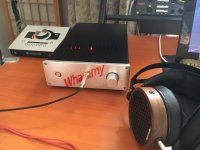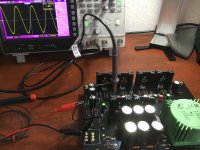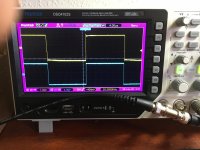Awesome!
Thank you so much 2 picoDumbs! As I said, my knowledge of all of this is suspect at best, and I think I got confused between ohms and kohms? Not sure.. Will report back!
John
Thank you so much 2 picoDumbs! As I said, my knowledge of all of this is suspect at best, and I think I got confused between ohms and kohms? Not sure.. Will report back!
John
Whew. Good spot. I knew someone would see the issue! Thanks!!! Also perfect testimony to why one of our venerable leaders here loves those dales.
Awesome!
Thank you so much 2 picoDumbs! As I said, my knowledge of all of this is suspect at best, and I think I got confused between ohms and kohms? Not sure.. Will report back!
John
No worries.
You'll have it all fixed before you know it.
I will try and find the naming convention for 100K
If there’s no “R” or “M” in the value place, the Dales are three digit plus multiplier. So as you suspect, 100K is 1003, 100+ three zeroes.
No worries.
You'll have it all fixed before you know it.
Boom Shakka Lakka! 2 picoDumbs.. Nailed it! Although I evidently didn't order the 100k resistors, my 13 year olds arduino kit came in to the rescue (temporarily until the real ones get here).. Sounds amazing! More volume than I can listen to now!
pFarrell.. Thank you for all of your help with this project.. (Although we are not done yet!).. Patrick has been answering questions from me like "What's this big blue box on the back of the board do?".. Appreciate your patience!
Thanks to all the pros watching these threads and offering your time and expertise!
john
Attachments
I like to DMM test my resistors before they are put on PCB.
By the way I had an interesting pre-amp test session a while ago using M2X as power amp. We were two "hifi-freaks" listening to Korg, Staving Student II and Whammy. They all sounded very good but conclusion was that Whammy came out on top which was for me a big surprise. My Whammy is with Burson V6 Classic op-amp. My M2X's is with Norwood input boards.
By the way I had an interesting pre-amp test session a while ago using M2X as power amp. We were two "hifi-freaks" listening to Korg, Staving Student II and Whammy. They all sounded very good but conclusion was that Whammy came out on top which was for me a big surprise. My Whammy is with Burson V6 Classic op-amp. My M2X's is with Norwood input boards.
That is always in 6L6's build guides, and it seems like really good advice.I like to DMM test my resistors before they are put on PCB.
Measuring everything is also a way to bypass values that are written too small. Speaking for me, and probably for others too.
I measure everything...
A very handy practice to help weed out the incorrectly marked resistors, I've had a few in the past - both banded and printed types.
Finished!!!
Hi just a quick post, Sooo My version of the Whammy is 18V trans, Dale , Nichicon, 3n30/3p20 fets, and OPA2134 to start with, V6 vivid on order, Tried the Clarity caps but decided on Mundorf caps, Mogami audio cable. I already have studio quality headphone amps in my studio but after listening to a PSP H/P amp I thought I could do better, so after much playing around with Chinese PCB's (none impressed me) I found the Whammy and bought the Very impressive PCB from the states, it did not take long to build at all (I think the board was beautiful to work on), and it came out like this (pictures Below). first I'm blown away by how quiet it is, no hums no hiss in fact very well behaved and luke warm components. The sound is very dynamic (headroom is impressive), clear, broad, and according to my oscilloscope V low THD, FFT showed a little second harmonic. So all in all 'I bloody love this little amp' and is going in the studio for personal vocalists to use. and for home when I can pinch it. Thank you guys for putting so much energy into this build and may you do more in the future. P.s I didn't bother with the safety cap on the input to earth, Should I?
Hi just a quick post, Sooo My version of the Whammy is 18V trans, Dale , Nichicon, 3n30/3p20 fets, and OPA2134 to start with, V6 vivid on order, Tried the Clarity caps but decided on Mundorf caps, Mogami audio cable. I already have studio quality headphone amps in my studio but after listening to a PSP H/P amp I thought I could do better, so after much playing around with Chinese PCB's (none impressed me) I found the Whammy and bought the Very impressive PCB from the states, it did not take long to build at all (I think the board was beautiful to work on), and it came out like this (pictures Below). first I'm blown away by how quiet it is, no hums no hiss in fact very well behaved and luke warm components. The sound is very dynamic (headroom is impressive), clear, broad, and according to my oscilloscope V low THD, FFT showed a little second harmonic. So all in all 'I bloody love this little amp' and is going in the studio for personal vocalists to use. and for home when I can pinch it. Thank you guys for putting so much energy into this build and may you do more in the future. P.s I didn't bother with the safety cap on the input to earth, Should I?
Attachments
Last edited:
It's worth at least trying it out.
If it was me I would install it.
Don't underestimate small details, they can sometimes have a significant effect.
If it was me I would install it.
Don't underestimate small details, they can sometimes have a significant effect.
No I did not put the caps on the feedback loop, I had them ready but when I tested the circuit there was no instability or oscillation going up to 20mhz so no caps. When I put the V6 vivid in I will test again but I'm not expecting to need to.
Last edited:
It's the overshoot on the square wave I see.
The cap will fix that.
You could try half or a quarter of the published value to see what it does.
It doesn't look like you need to add very much.
The cap will fix that.
You could try half or a quarter of the published value to see what it does.
It doesn't look like you need to add very much.
Pico. Thanks I'll try the caps, I must admit I thought the caps were to suppress any instability like oscillations so I've learned something today, Thanks for the info.
It can do both.
Try small values.
Don't solder them just touch the cap leads across the resistor leads while looking at the square wave response.
Once you find the cap value that gives you the response you like then solder in.
Try small values.
Don't solder them just touch the cap leads across the resistor leads while looking at the square wave response.
Once you find the cap value that gives you the response you like then solder in.
- Home
- Amplifiers
- Pass Labs
- "WHAMMY" Pass DIY headphone amp guide




